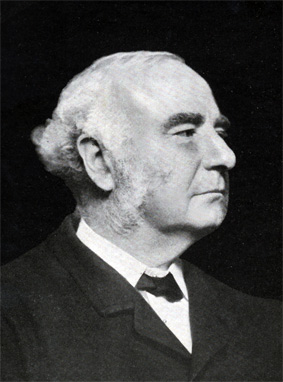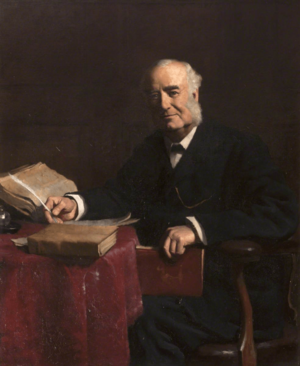Alfred Newton facts for kids
Quick facts for kids
Alfred Newton
|
|
|---|---|
 |
|
| Born | 11 June 1829 |
| Died | 7 June 1907 (aged 77) |
| Alma mater | Magdalene College, Cambridge |
| Awards | Royal Medal (1900) Linnean Medal (1900) |
| Scientific career | |
| Fields | Zoology Ornithology |
| Institutions | Cambridge University |
Alfred Newton FRS HFRSE (11 June 1829 – 7 June 1907) was an English zoologist and ornithologist. Newton was Professor of Comparative Anatomy at Cambridge University from 1866 to 1907. Among his numerous publications were a four-volume Dictionary of Birds (1893–6), entries on ornithology in the Encyclopædia Britannica (9th edition) while also an editor of the journal Ibis from 1865 to 1870. In 1900 he was awarded the Royal Medal of the Royal Society and the Gold Medal of the Linnaean Society. He founded the British Ornithologists Union.
Life
Alfred Newton was born near Geneva in Switzerland, the fifth son of William Newton of Elveden Hall in Suffolk, Member of Parliament (MP) for Ipswich; his mother Elizabeth (1789–1843) was the daughter of Richard Slater Milnes, MP for York. The family wealth was founded on sugar plantations in the Caribbean, where Alfred's grandfather Samuel Newton had a plantation in St Kitts, and a property in St Croix. William Newton returned to England in 1813, purchasing the property of Elveden, near Thetford from the Earl of Albemarle. Elveden (pronounced and sometimes spelt 'Eldon') was built in 1770 by Admiral Augustus Keppel. After the Newtons left, Elveden Hall and its estate were bought by Prince Duleep Singh in 1863, and later by the Guinness family (Earl of Iveagh).
In 1828 the Newton family made a trip to Italy, and on the way back Alfred was born on 11 June 1829 at Les Délices, a chateau near Geneva. He suffered an accident when about five or six, which left him somewhat lame in one leg. He went to school in 1844, attending Mr. Walker's school at Stetchworth near Newmarket. He kept birds in cages and looked after other animals from a young age.
As a youth Newton shot game birds – black or red grouse, common pheasant, partridge. Birds became an abiding interest. Those included the great bustard (Otis tarda), Montagu's harrier (Circus pygargus), ravens, buzzards (Buteo sp.), redpolls, wrynecks (Jynx), which are small woodpeckers that specialise in feeding on ants. "The vast warrens of the 'Breck', the woods and water-meadows of the valley of the Little Ouse, and the neighbouring Fenland made an ideal training-ground for a naturalist". This enthusiasm Newton shared with his younger brother Edward: the two carried out bird observation when they were together and corresponded when they were apart.
In 1846 Newton went to a tutor in Biggleswade for a few months, and in 1848 he entered Magdalene College, Cambridge. He graduated B.A. in 1853. He took a particular interest in zoology and corresponded with many ornithologists of the time. A meeting with John Wolley at Cambridge in 1851 made them lifelong friends. He spent the rest of his life at Magdalene, and never married. A fall later in life, when he was on a trip to Heligoland, further crippled him, and he then walked with the aid of two sticks, instead of one, as formerly. "From a three-legged, he has become a four-legged man" commented a friend.
Newton died on 7 June 1907 of heart failure at the Old Lodge in Magdalene. He is buried in the Parish of the Ascension Burial Ground in Cambridge.
Career
In 1853 he was awarded the Drury Travelling Fellowship of Magdalene College, but he took it up only in 1855, when the grant became available. Between 1855 and 1864 he visited many parts of the world, including Lapland, Iceland, Spitsbergen, the West Indies and North America. In 1858 he made a trip to Iceland with John Wolley with the hope of rediscovering the great auk. Shortly after their return Wolley died, and at the suggestion of P.L. Sclater Newton wrote up Wolley's notes and catalogued his collection in Ootheca Wolleyana, which was published in four parts from 1864 to 1907. In 1866 he became the first Professor of Zoology and Comparative Anatomy at Cambridge, a position which he retained until his death. His portrait still hangs in the library of the University's Department of Zoology. Newton was also a founding editor of the Journal of Anatomy and Physiology in 1867. He was one of the few British Professors of Zoology of his time in whose appointment Huxley did not have a hand. Both Darwin and Huxley declined to support his application, on the grounds that his interests and publications were too narrowly focussed on ornithology. The procedure was for candidates to canvass for votes (presumably amongst the MAs of the University). The result of the poll was Newton 110; Dr Drosier 82. Newton was one of the first zoologists to accept and champion the views of Charles Darwin, and his early lecture courses as professor were on evolution and zoogeography.
Newton was a leader in founding the British Ornithologists' Union in 1858, and its quarterly journal, the Ibis in 1859. He wrote several books including Zoology (1872) and A Dictionary of Birds (1893–1896). He contributed memoirs to scientific societies, and edited the Ibis (1865–1870), the Zoological Record (1870–1872), and Yarrell's British Birds (1871–1882). His services to ornithology and zoogeography were recognized by the Royal Society in 1900, when it awarded him the Royal Medal.
Newton spent some time studying the vanishing birds of the Mascarene Islands, from where his brother Sir Edward Newton sent him specimens. These included the dodo on Mauritius and the solitaire on Rodrigues, both already extinct. In 1872 he described what is now known as Newton's parakeet which lived on Rodrigues before going extinct in 1875. The specific epithet of Genyornis newtoni, a prehistoric bird described in 1896 by Edward Charles Stirling and A. H. C. Zietz, commemorates this author.
Bird conservation
Newton's interest in extinct bird species such as the dodo, great auk and great bustard led him to work towards the protection of birds. He influenced the legislation of the Sea Birds Preservation Act 1869. Newton was a prominent supporter and member of the Society for the Protection of Birds (later, 1903, the RSPB) from its inception in 1889, and carried on a long campaign to influence women against the fashion of adorning their hats with the flight feathers of raptors and other fine birds. His letters to The Times and addresses to the British Association for the Advancement of Science meetings on this subject were regularly reprinted as pamphlets by the Society. Newton determined that extinction cause by human actions was different from extinction resulting from natural processes including evolution. He made efforts to clarify that his motivations for conservation were scientific and that these were distinct from sentiments influenced by earlier movements against animal cruelty and vivisection.
One of his most successful works was a series of investigations into the Desirability of establishing a 'Close-time' for the preservation of indigenous animals. These were instigated and published by the British Association between 1872 and 1903, leading towards the present-day legislation concerning the closed seasons for game fish, shell-fish, birds and mammals (Game laws). The basic concept, as is now well known, is to protect animals during their breeding season so as to prevent the stock from being brought close to extinction.
The Cambridge University Museum of Zoology contains a significant amount of material from Newton, including specimens collected in Madagascar, Polynesia, South America and the Caribbean, eggs, books and correspondence.
Partial list of publications
- Newton A. (1864–1907), Ootheca Wolleyana: 1. An illustrated catalogue of the collection of birds' eggs formed by the late John Wolley 2. Eggs of the native birds of Britain and list of British birds, past and present. The first part was published in 1864; it was not until 1902 that Newton was able to resume the work and the next parts appeared in 1902, 1905 and 1907. The work is illustrated with colour lithographic plates and with black & white illustrations. Artists include Newton, Balcomb, Grönvold, M. Hanhart, J. Jury, and Joseph Wolf. The 11th edition of the Encyclopædia Britannica comments: "[This] was an amplification of the numerous articles on birds which he contributed to the 9th edition of the Encyclopædia Britannica".
-
-
-
- Please note that a wikilink to the article on [Birds] in [EB9] is not available***
- Please note that a wikilink to the article on [Dodo, extinct bird.] in [EB9] is not available***
-
-
-
-
-
- Please note that a wikilink to the article on [Ornithology] in [EB9] is not available***
-
-
- Newton A. (assisted by Hans Gadow, with contributions from Richard Lydekker, Charles S. Roy and Robert Shufeldt) (1893–1896), Dictionary of Birds. Reprinted in one volume (1088 pages) Black, London, 1896.
- Newton A. et al. (1896–1903), Bird migration in Great Britain and Ireland. Reports of the Committee... British Association.
See also
- Alfred Newton Lecture
- T.H. Huxley
- 1860 Oxford evolution debate
- Reaction to Darwin's theory
- William Henry Flower
- X Club
- Journal of Anatomy



